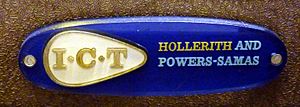International Computers and Tabulators facts for kids
International Computers and Tabulators, or ICT for short, was a big British company that made computers. It started in 1959 when two companies, the British Tabulating Machine Company (BTM) and Powers-Samas, joined together. Later, in 1963, ICT also bought the computer parts of another company called Ferranti. ICT sold its computers to many countries around the world. In 1968, ICT became part of an even bigger computer company called International Computers Limited (ICL).
Contents
Early Computers from ICT
ICT made many different types of computers. Some of their first machines used older technology, while others were quite advanced for their time.
The ICT 1101
The ICT 1101 was actually known as the EMIDEC 1100 before ICT took over the company that designed it. This computer was one of the early models.
The ICT 1201
The ICT 1201 was an older type of computer. It used vacuum tubes, which were like light bulbs and made the computer very large and hot. Its main memory was a magnetic drum, which stored information by spinning very fast.
You put information into the 1201 using punched cards, which were cards with holes punched in them. The computer would then print results or punch new holes into cards for output. The 1201 was originally called the HEC4 before the companies merged.
How the 1201 Worked
The drum memory in the 1201 could hold 1,000 "words" of information. Each word was 40 bits long. Programmers had to be very clever when writing instructions for this computer. They had to space out the instructions so that the next instruction would be ready to read from the spinning drum exactly when the computer finished the previous one. This made sure the computer worked as fast as possible.
The ICT 1301 and 1300
The ICT 1301 and its smaller version, the ICT 1300, were more modern. They used germanium transistors instead of vacuum tubes, making them smaller and more reliable. They also had core memory, which was a faster way to store information.
These computers could store extra information on magnetic drums or on different sizes of magnetic tape, similar to old cassette tapes. You could put information in using punched cards or paper tape. The computer would then print results or punch new cards or paper tape.
Special Features of the 1301
The very first ICT 1301 was delivered in 1962 to the University of London. A cool thing about these computers was that they could do British money calculations (pounds, shillings, and pence) directly in their hardware. This was very helpful because British money used to be quite complicated!
Programmers also liked the 1301 because they didn't need to learn binary (base 2) or octal (base 8) numbers. The computer's instructions and its math unit only used decimal numbers (base 10). The computer's internal clock ran at 1 MHz, which was fast for its time. Amazingly, a 1301 machine from London University still exists today and a group of people are working to get it running again!
The ICT 1302
The ICT 1302 was like the 1300/1301 but even more powerful. It could run three different programs at the same time, plus its main Executive program. This is called multiprogramming. It also used a "Standard Interface" to connect to other devices, which made it very flexible. This interface was first tested on the 1301 and later used in the popular 1900 series.
The ICT 1400
The ICT 1400 was meant to be an early computer using vacuum tubes. However, by 1959, transistor technology was becoming popular, so the 1400 was never sold.
The ICT 1500 Series
The ICT 1500 series was not designed by ICT itself. It was a design bought from an American company called RCA. RCA called their version the RCA 301. Other companies, like Siemens in Germany and Compagnie des Machines Bull in France, also used this design. The 1500 series used a six-bit byte (a small unit of computer information) and could store between 10,000 and 40,000 bytes in its core memory.
The ICT 1900 Series
After ICT bought parts of Ferranti, they gained access to a new and very advanced computer called the Ferranti-Packard 6000. ICT decided to adapt this machine to use their "Standard Interface." This new computer was then sold as the ICT 1904. It was the first in a line of computers that could all work together, meaning programs written for one could often run on another.
The End of ICT
In 1968, ICT joined with another large company called English Electric Computers. This new, even bigger company was named International Computers Limited (ICL). At the time of the merger, English Electric Computers was making large computers similar to the IBM System/360. These were sold as the ICL System-4. Eventually, both the 1900 series and the System-4 were replaced by the ICL 2900 Series, which came out in 1974.
Images for kids



